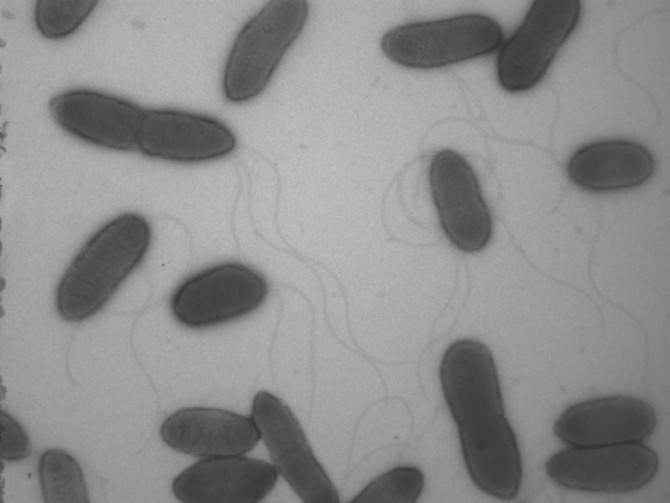Study: Jumping gene steals bacterial ‘gene-editing’ system
By Krishna Ramanujan
A study describes for the first time evidence of "jumping genes" adopting a bacterial immune mechanism for transferring genetic material between bacteria and across bacterial species. The finding has implications for developing an efficient and accurate gene-editing technology for any species, though that promise is preliminary at this time.
The study employed bioinformatics – which uses computational methods and software tools to understand biological data – to survey 50,000 bacterial genomes. Through this technology the study’s authors discovered evidence of the newly described mechanism.
The paper, published Aug. 15 in the Proceedings of the National Academy of Sciences, describes a type of transposon, or “jumping gene,” nicknamed for its ability to move and insert itself in DNA. This type of jumping gene, known as Tn7 and Tn7-like elements, contains cargo areas that can hold 100 or more genes that are inserted along with the element into a host’s genome. Tn7 elements are responsible for spreading antibiotic resistance between bacteria and can transfer genes between bacteria across the planet, from deep-sea hydrothermal vents, to soils, to food.
The study reports the discovery of Tn7-like jumping genes that have adopted a truncated version of bacteria’s defense system, called a CRISPR-Cas system. Over the last few years scientists have used modified CRISPR-Cas systems for gene editing, where they cut into any species’ genetic code and can subsequently replace the information with a slightly altered code to create new traits.
CRISPR-Cas technologies are now widely used in medicine and agriculture, and offer vast possibilities for fighting genetic diseases and for altering genomes of plants, animals and even human cells for desired effects.
With regard to bacteria, “We are really starting to get a window into what those bacteria are doing, how they evolve, and we are seeing this superhighway where genetic information gets to be moved around. These [bacterial] genes can go anywhere,” from one bacterium to another, said Joseph Peters, Cornell professor of microbiology and the paper’s lead author. Peters and Eugene Koonin, senior investigator at the National Center for Biotechnology Information, are co-corresponding authors on the paper.
Koonin was conducting a survey of bacterial genomes for novel CRISPR-Cas systems when he discovered a possible association with Tn7-like jumping genes. Working together, Peters and Koonin’s group were able to reveal three independent occurrences over evolution where Tn7-like elements captured the CRISPR-Cas system.
Currently, scientists have modified bacterial immune systems known as CRISPR (clustered regularly-interspaced short palindromic repeats) to edit genes. CRISPR systems are part of the bacteria’s natural defense primarily against bacterial viruses, called phages. When a phage infects a bacterium but doesn’t kill it, that bacterium takes a piece of that viral DNA and remembers it in the form of guide RNA. RNA is the molecule used by all organisms to transmit genetic information from DNA to proteins, but in this case the RNA has been modified to serve as a guide that recognizes a sequence of viral DNA. When bacteria are re-infected by the same virus, the guide RNA directs CRISPR-associated proteins (Cas proteins) to that precise string of viral DNA. Once located, these Cas proteins cut the viral DNA and disable the virus.
The researchers searched through 50,000 bacterial genome sequences and identified almost 11,000 Tn7-like elements, a subset of these were shown to specifically associate with a novel truncated CRISPR-Cas system.
“Right now, it’s circumstantial evidence that these CRISPR-Cas systems have been stolen by these transposons [jumping genes] as a tool to recognize new sites” in bacteria for inserting genetic information, said Peters.
CRISPR-Cas systems contain a guide RNA to recognize DNA sequences, but the bioinformatics data suggests Tn7-adapted systems mostly recognize DNA sequences within mobile genetic elements called plasmids, which can be transported between bacteria. Plasmids are naturally occurring, small, circular, double-stranded DNA molecules that are distinct from a bacteria’s chromosomal DNA. Because plasmids are mobile and are transferred between bacteria, genes carried in plasmids move and provide bacteria with genetic advantages, such as antibiotic resistance.
Interestingly, the Tn7-associated Cas proteins don’t possess a component to cut and destroy the targeted DNA like normal CRISPR-Cas systems, something that would be expected if they were using the plasmids as a transfer vehicle. This supports the idea that Tn7 elements are guided to a piece of plasmid DNA, where they insert themselves and their genetic payload into plasmids, allowing for the spread of that genetic material. The Peters lab is currently working to prove their finding in a variety of live bacteria.
The study was funded by a U.S. Department of Agriculture Hatch grant and the U.S. Department of Health and Human Services.
Media Contact
Get Cornell news delivered right to your inbox.
Subscribe